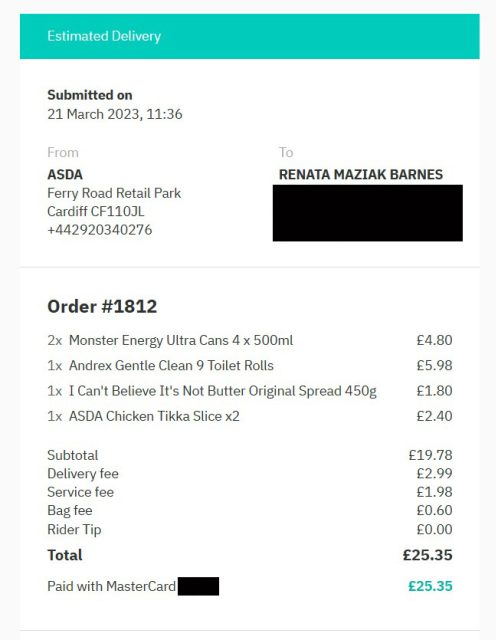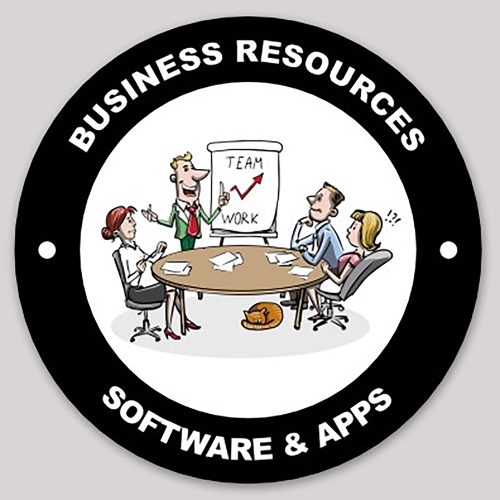
Asda Cardiff Bay & Deliveroo 21/03/23 No-Show Delivery – Bad Review
Today I placed an order with Deliveroo at 11.43 hours, within two hours of waiting I saw 5 riders arrive, wait, and come and go. I wasted over two hours of my time waiting. Not only this it was a waste of time for the 5 riders and petrol as not all riders deliver on bikes, plus the carbon emissions.
Deliveroo who was talking with the last rider at 13.58, stated that no one was coming out with my order and when the rider found a member of staff they said there was no order for me and that it should have been canceled at the time I placed it.
Let me explain about the store, they are one the largest supermarkets in Cardiff, so for items to be out of stock is unusual.

About Asda Cardiff Bay Wales
Asda Cardiff Bay in Wales is a popular shopping destination for locals and visitors alike. This branch of the British supermarket chain is located in the heart of Cardiff Bay, one of the city’s most vibrant and attractive areas. Asda Cardiff Bay also works closely with local suppliers to source fresh produce and other items, helping to support the Welsh economy.
In addition to its grocery offerings, Asda Cardiff Bay has a number of other departments, including a pharmacy, opticians, and a photo center. The pharmacy offers a range of prescription medications, as well as over-the-counter remedies and health and wellness products.
Asda Cardiff Bay also offers a number of services to make shopping easier and more convenient. For example, customers can order groceries online and have them delivered straight to their doorstep. There is also a Click & Collect service, which allows customers to order online and then pick up their items in-store at a time that is convenient for them.
About Deliveroo
Deliveroo is a food delivery company that was founded in London, UK in 2013. It has since expanded to operate in over 200 cities across 12 countries, including Australia, France, Germany, Ireland, Italy, the Netherlands, Singapore, Spain, Taiwan, United Arab Emirates, Kuwait, and the United Kingdom. The company’s mission is to revolutionize the way people eat by connecting them with their favorite local restaurants and enabling them to order food quickly and conveniently.
Deliveroo offers a platform where customers can order food from their favorite local restaurants and have it delivered to their doorstep. Customers can place orders using the Deliveroo website or mobile app, and the company’s delivery riders, known as ‘Roos’, pick up and deliver the orders. The company operates on a fee-based model, taking a percentage of the order value as commission from the restaurant, while customers pay a delivery fee.
Deliveroo focuses on technology. The company has developed an advanced algorithm that predicts which restaurants will be the most popular at any given time, allowing the platform to optimize its delivery routes and reduce delivery times.
The company has also invested in artificial intelligence and machine learning technologies, allowing it to provide personalized recommendations to customers based on their previous orders and preferences.
However, Deliveroo has also faced criticism from some quarters, particularly from workers’ rights groups who argue that the company’s riders are not classified as employees and therefore do not receive the same protections and benefits as traditional employees. The company has also been accused of using an exploitative business model that leaves riders underpaid and overworked.
Deliveroo should charge a membership subscription fee to the restaurants as well as a commission for each order without charging the customer for service & delivery fees. The restaurant/grocery store should also be charged by Deliverro if they cancel the orders without notifying Deliveroo or the Customer.
My Personal Interaction with Deliveroo
It was on my last call with Deliveroo that I lost it. This is not the first time I have had to wait over two hours from the time I placed my order for them to have the order canceled.
Deliveroo over 3-hour wait time. | iRENATA.COM – RENATA ENTREPRENEUR
I tried phoning the Asda store and a robot spoke giving me options to press 1,2,3 for XYZ, and finally cut me off. Deliveroo also could not get hold of the store. With profits, these grocery companies make you would think they could afford humans to answer their phones. If you are providing a service and it is not being met to the standards that customers are accustomed to, do not bother providing the service at all.
It was nothing to do with my order as I had stipulated if there were items missing cancel the whole order, but Asda accepted the order without canceling and did not update the system where I was put in limbo.
I have a disability and do not need stress in my life at all. So when Deliverro kept telling me to be patient, how much time was I supposed to give? After the call ended I started getting chest pains. There are consequences to people’s actions that can cause a domino effect.
I stated I would give Deliveroo a run for its money because why are they charging the advertiser and customer for the service charges? It should be the responsibility of the restaurant/grocery store to pay these charges.
Poor Customer Service
Customer service is an integral part of any business, as it is the key to building a loyal customer base. It is the face of the company that interacts with customers and creates an impression in their minds. However, poor customer service can have a negative impact on the company’s reputation and ultimately lead to the loss of customers.
In this article, we will discuss the consequences of poor customer service and ways to avoid it.
Consequences of poor customer service
- Loss of customers: Customers are the backbone of any business. Poor customer service can lead to the loss of customers who may choose to take their business elsewhere. Customers who are not satisfied with the service they receive are unlikely to return and may even discourage others from doing business with the company.
- Negative reviews: Social media and review sites have given customers a powerful voice. Poor customer service can lead to negative reviews and comments that can damage the company’s reputation. These negative reviews can discourage potential customers from doing business with the company.
- Decreased revenue: Losing customers can lead to decreased revenue. Poor customer service can also lead to missed opportunities to upsell or cross-sell products or services to customers.
- Increased costs: Poor customer service can increase costs for the company. It can lead to increased customer complaints, which require additional resources to resolve. It can also lead to lost sales, which can impact the company’s bottom line.
Ways to avoid poor customer service
- Training: Proper training is essential for customer service representatives to provide excellent service. Training should focus on communication skills, problem-solving, and product knowledge. Regular training sessions should also be conducted to keep representatives updated on new products, services, and policies.
- Empowerment: Customer service representatives should be empowered to make decisions and resolve issues on their own. This can reduce the time it takes to resolve customer issues and improve the customer experience.
- Feedback: Collecting feedback from customers is essential to improve customer service. Companies should encourage customers to provide feedback through surveys, feedback forms, or social media. This feedback can help identify areas for improvement and make necessary changes.
- Transparency: Companies should be transparent about their products, services, and policies. Customers should have easy access to information about products, pricing, and return policies. This can help prevent misunderstandings and reduce the number of customer complaints.
Poor customer service can have a negative impact on a company’s reputation and bottom line. However, by focusing on training, empowerment, feedback, and transparency, companies can avoid poor customer service and provide an excellent customer experience. It is essential to understand that customer service is not just a department; it is a philosophy that should be ingrained in the company’s culture. By prioritizing customer service, companies can build loyal customers.
Should retailers compensate if they provide poor service?
As a consumer, there are few things more frustrating than receiving poor service from a retailer. Whether it’s a faulty product, slow shipping, or unresponsive customer service, a negative shopping experience can leave a lasting impression and impact your decision to do business with that retailer again in the future. So, should retailers offer compensation if they provide poor service? Let’s explore the pros and cons.
On the one hand, offering compensation for poor service can help to mitigate the negative impact of a poor shopping experience on the customer. If a retailer is willing to offer a refund, store credit, or a discount on a future purchase, it shows that they value the customer’s business and are willing to take responsibility for any mistakes or shortcomings in their service. This can help to build trust and loyalty with the customer, and potentially even turn a negative experience into a positive one.
Furthermore, offering compensation can also help to prevent negative reviews or feedback from spreading online. In today’s digital age, customers have more power than ever to share their experiences with others, and a negative review can quickly go viral and damage a retailer’s reputation. By offering compensation, retailers can potentially prevent a negative review from being posted in the first place, or at least show other potential customers that they are willing to go above and beyond to make things right.
On the other hand, offering compensation can also be costly for retailers. Depending on the extent of the poor service or the number of customers affected, offering refunds or discounts can add up quickly and eat into the retailer’s profits. Additionally, some customers may try to take advantage of the offer and falsely claim that they received poor service in order to get free products or discounts.
Moreover, offering compensation may also create unrealistic expectations for customers. If a retailer becomes known for always offering compensation for any negative experience, some customers may start to expect it as a given, even for minor issues. This can lead to a culture of entitlement and potentially harm the retailer’s bottom line.
Ultimately, it depends on the situation and the severity of the poor service. In some cases, offering compensation can be a smart business decision that helps to build trust and loyalty with customers, while in others it may not be worth the cost. Ultimately, retailers should strive to provide the best possible service to their customers in the first place and have clear policies and procedures in place for handling any issues that may arise. By doing so, they can minimize the likelihood of poor service occurring in the first place, and potentially avoid the need for compensation altogether.
The domino effect of a retailer providing poor customer service
Unfortunately, when retailers fail to meet the needs and expectations of their customers, it can have a domino effect that impacts not only the customer experience, but also the retailer’s reputation, revenue, and long-term success.
The following are some of the potential consequences of a retailer providing poor customer service:
- Negative Word of Mouth: When a customer has a negative experience with a retailer, they are likely to share that experience with others. This can be through social media, online reviews, or simply telling friends and family members. Negative word of mouth can quickly spread, damaging the retailer’s reputation and discouraging potential customers from doing business with them.
- Decreased Customer Loyalty: Customers who receive poor service are less likely to return to a retailer in the future. In fact, according to research by Zendesk, 82% of consumers have stopped doing business with a company due to poor customer service. This can lead to a significant decrease in revenue over time as the retailer loses repeat business.
- Lower Sales: Poor customer service can also result in lower sales. Customers who have a negative experience are less likely to make additional purchases or spend as much money as they would have if they had received good service. This can have a significant impact on a retailer’s bottom line.
- Increased Costs: Providing poor customer service can also result in increased costs for the retailer. For example, the retailer may need to spend more money on advertising and marketing to attract new customers to make up for those who have been lost due to poor service. Additionally, the retailer may need to invest in training programs and other initiatives to improve the quality of their customer service, which can be expensive.
- Legal Consequences: In some cases, poor customer service can lead to legal consequences for the retailer. For example, if a customer is injured due to the retailer’s negligence, the retailer may be held liable for any damages. This can result in expensive lawsuits and damage to the retailer’s reputation.
Conclusion
Providing poor customer service can have a significant impact on a retailer’s reputation, revenue, and long-term success. Retailers who fail to meet the needs and expectations of their customers risk losing their business, damaging their reputation, and incurring significant costs. It is essential for retailers to prioritize customer service and invest in initiatives that can help them improve the quality of their interactions with customers.
When customers experience poor service, they may feel frustrated, angry, or disappointed. These emotions can trigger the body’s stress response, which can lead to physical health problems.
I found the general manager “Rea Raymond” of the store who will get a link to this article about my disdain: https://www.linkedin.com/in/rea-raymond-534876119/ For reference my order number was 1812, which got refunded and credit was put on from Deliveroo for delivery and service fees of £5.00, although Asda is oblivious to what has happened and I am not happy.
No doubt one will blame the other and pass the buck “it wasn’t us it was them” scenario at the expense of the consumer.
The lesson I have learned today is I will never order from Asda ever again. Will I pursue this, most probably not, but if it happens again I will sing like a canary.
“As a domain broker, content writer, digital marketer, and website developer, every minute I am on the phone I could be losing a customer, hence normally I communicate by email or chat, however on this occasion, I had no option but to call”.

“The moral of the story is to treat customers with respect and dignity and if you fail to provide a good standard of service do not just say “I’m sorry”, words mean nothing when people have been disadvantaged. A happy customer will tell their friends and family, an unhappy customer will tell the world”.
“Apologies will not bring food to the table (no pun intended) when a customer has to spend more than 30 minutes on the phone sorting the mess out, instead of working”!
Imagine someone else having to wait around, having to reschedule their agendas because two companies cannot get their acts together. What if this caused them to be late for an appointment, there are a lot of what if’s. I will give Deliveroo another chance, although if they have three strikes, they will lose my business for good. I could not rate my experience on Deliveroo, against the store, but they did send me an email to rate the telephone operative.




#asdacardiffbay #deliveroo #rearaymond #generalmanagerasda #poorcustomerservices #apallingservice#servicefees #dominoeffect #emotionaldistress #negativereviews #badreviews


































